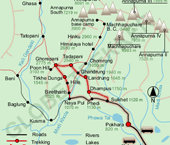
» Ville fjell og vennlige mennesker
» Nepalsk ornitolog kikket pa Lista
» Namaste Nepal passer for reiseskildringer














&
Temparature
10 Days Nepal Trips with Annapurna Balcony Ghorepani
Poonhill Trekking:
 Day 1: Arrival in Kathmandu airport meets and transfers to hotel Everest or similar rest and welcome dinner (typical Nepali food with culture program) in the evening.
Day 1: Arrival in Kathmandu airport meets and transfers to hotel Everest or similar rest and welcome dinner (typical Nepali food with culture program) in the evening.
The Kathmandu Valley:
It is surrounded by a tier of green mountain wall above which tower mighty snow- Capped peaks. It consists of three main towns of great historic, artistic and culture interest. (Kathmandu, Patan and Bhaktapur). The Kathmandu valley covers an area of 218 sq. miles. It is actuated 4223 ft. above sea-level. The ancient Swasthani scriptures tell of Lord Shiva, supreme among Hindu gods, who came down to the Kathmandu valley to escape boredom. He came as a tourist, if that is the appropriate word, but he was neither among the first nor the last of the gods to visit the Valley. Visitors have come to Nepal since time forgotten. And though the country is much different today then it was in ancient times, it has not diminished in charm; the increase in the number of visitors over the years is a living proof. Those who came to the Valley today will appreciate a lot more then Lord Shiva did in his tour. The architecture started here by the Lichhavi and Malla Kings is one such example. Much of the greenery that Lord Shiva is gone, but the forest surrounding Pashupatinath, where he stayed, is still intact. The seven World heritage Sites in Kathmandu Valley designated by the United Nations Educational, Scientific, and cultural Organization (UNESCO) are the highlights of the Valley.
Day 02: after breakfast sightseeing tour in Kathmandu with guide,
Swoyambhunath
The history of the Valley, according to the legends, begins with Swoyambhunath, or the “the self-existent”. In times uncharted by history, Bodhisattva Manjusri came across a beautiful lake during his travel. He saw a lotus that emitted brilliant light at the lake’s center, so he cut a gorge in a southern hill and drained the waters to worship the lotus. Men called it the Kathmandu Valley. From then on, the hilltop of the Self-existent Lord has been a holy place.
Kathmandu Durbar Square
It is easy to be overwhelmed by the seemingly uncountable monuments in the durbar square, the house of the Living goddess, the ferocious Kal Bhairab, the red monkey god, and hundreds of erotic carvings are a few examples of the sights at the square! The building here is the greatest achievements of the Malla dynasty, and they resulted from the great rivalry between the three palaces of Kathmandu, Patan and Bhaktapur. The valley was divided among the children of Yaksya Malla. For visitors today, and for the Nepalese, it was serendipitous that they, and later their off springs, began artistic warfare trying to outdo each other in splendid constructions. Kings copied every thing their neighbors built in an even grander style. A visitor who wanders around the Square will see a round temple in the Pagoda architectural style, the temple of goddess Taleju (who played dice with King Jaya Prakash Malla), and an image of Shiva and Parbati sitting together among the many monuments.
The Square is teeming with colorful life. Vendors sell vegetables, curios, flutes, and other crafts around the Kathmandu rest house. This rest house is said to have been built with the wood of a single tree and is the source from which the Kathmandu valley got its name. Nearby are great drums which were beaten to announce royal decrees. All woodcarvings, statues, and architecture in this area are exceptionally fine, and Durbar Square is among the must important sights for Travelers to see.
Pashupatinath:
One-day lord Shiva got tired of this glittering palace on Mt. Kailash, his armies of ghosts and spirits, and even Parbati – his beautiful wife. Through his cosmic powers, he searched for a perfect place where he could holiday. Without telling anyone, he ran away from his palace and came to live in Slesmantak forest in the Kathmandu valley. He gained great fame here as Pashupatinath – Lord of the Animals – before other gods discovered his hiding place and came to fetch him. The Pashupatinath where he stayed has received the attention of worshippers for at least fifteen hundred years; it is the holiest Hindu pilgrimage destination in Nepal. There are linga images of Shiva along with statues, shrines, and temples dedicated to other deities in the complex. A temple dedicated to Shiva existed at this site in AD 879. However, the present temple was built by King Bhupatindra Malla in 1697. A gold – plated roof, silver doors, and woodcarving of the finest quality decorate the pagoda construction. Guheswori Temple, restored in AD 1653, represents the female “force”. It is dedicated to Satidevi, Shiva’s first wife, who gave up her life in the flames of her father’s fire ritual.
Boudhanath:
Bouddhanath is among the largest stupa in south Asia, and it has become the focal point of Tibetan Buddhism in Nepal. The white mound looms thirty-six meters overhead. The stupa is located on the ancient trade route to Tibet, and Tibetan merchants rested and offered prayers here for many centuries. When refugees entered Nepal from Tibet in the 1950s, many of them decided to live around Bouddhanath. They established many gompas, and the “Lit the Tibet” of Nepal was born. This “Little Tibet” is still the best place in the valley to observe Tibetan lifestyle. Monks walk about in maroon robes. Tibetans walk with prayer wheels in their hands and the rituals of prostration are presented to the Buddha as worshippers circumambulate the stupa on their hands and knees, bowing down to their lord. Over night at hotel.
Day 03 Fly or Drive from Kathmandu to Pokhara arrive in hotel bit refreshment and little sightseeing tour and over night hotel in Pokhara.
Pokhara:
Pokhara is a rare combination of the long arrays of Snow clad peaks, crystal clear lakes, turbulent rivers with deep gorges and picturesque villages inhabited by simple and friendly ethnic people. Situated at the lap of the panoramic Annapurna Himal, the climate of Pokhara remains favorable all the year round neither too warm nor too cold. The monsoon rains are strongest during June to August. Other months are relatively dry.
The moment you step into any part of Pokhara the first thing that takes you to immediate delight is the gorgeous view of the gigantic mountains. Pokhara is infarct, the first and foremost convenient point for mountain-oriented sightseeing. Mt. Annapurna, literally meaning the Goddess of Abundant Harvest, lies at a horizontal distance of 40 km. from the valley of Pokhara which is at an elevation of just 900 meter above main sea level.
Lake
Pokhara is a city of fine lakes with crystalline water. Phewa Tal is in the immediate vicinity of the city is with an island temple dedicated to Goddess Barahi in the middle. With its serene water reflecting the Annapurna range and a nicely preserved forest on the adjoining southern slope, this legendary second largest lake of the Kingdom remains a major source of attraction for the visiting tourists. This lake can also be enjoyed by swimming. Begnas & Rupa, these twin lakes lie in the north-east of Pokhara valley about 15 km away from the airport. The road to Begnas follows Kathmandu-Pokhara Highway as far as Sisuwa near the police check post and branches off the road towards north. It is possible to take a bus ride to the dam side of Begnas from the city.
TEMPLES
Two temples are really worth visiting in the Pokhara area. Bindabasini temple some way between downtown Mahendrapul and Bagar is one of them. The temple is located on top of a beautiful mound overlooking the most popular area of the Pokhara city. The road to Sarangkot starts from the foot of this mound.
The next one is Barahi temple situated on a small island in the middle of Phewa Tal. A stop at this serene temple after a canoe ride is really worthwhile. There is a nice Buddhist monastery on the top of a small forested hill above Matepani east of Mahendrapul. It overlooks the majority of Pokhara area. A little south of this monastery on another small but beautiful hill in a pleasant sylvanic setting lies Bhadrakali temple which is also worth visiting.
Poon hill Ghorepani Chhomrung trek
Day 04, Drive from Pokhara to Nayapul, and trek to Tikhedhunga (1577M.)
Trek Summary
Annapurna Areas {4/21days} this is very popular trekking area in Nepal. It is very beautiful for its mountain scenery, section Of Nepal. Trek can start Besisahar & many option s places for those who like to do long & short (easy & adventure) Trek. Trekkers they have to walk through Green fields of paddy & banana groves, into oak bamboo, pine, rhododendron, & many kinds of tree lines. Eventually emerging into high desert places, high passes, religious place, holly place [for Hindu & Buddhist] & historic furriers town. This trek gives you ample opportunity to observe the Culture & life style of at least a half dozen ethnic groups an exposition more then any other trek.
Trekking starting:
After having break fast about 8.30 a.m. leave for trek, one and half hour drive (42k.m) The drive gives you wonderful chance to see the view of full Pokhara valley with Annapurna & Fishtail in background. Start walk from Nayapul (1050m.), after half-hour walk stop for lunch at Birethanti. After lunch easy walk for two-hour following the Bhurendi khola, you will meet Gurung village, people are busy in their field. The nature is pretty to see. As soon as you reach to Bhuk Deaurli the trail leads you up hill towards Tikhedhunga (1500m) for one and half-hour more. The Tikhedhunga is our night camp for that night right before the serious up of Ulleri (about 3000 steps).
Day 05, Trek to Ghorepani (2850M.)
After break fast start walk towards Ghorepani (2850 m.) For 6-7 hrs. Starting 3hrs is serious up hill through village and terrace. After one and half-hour walk you will get chance to see the view of Annapurna south (7219m) and Himchuli (6444m). That view does not move away from your eye for another one and half-hour. The place named Banthanti is our lunch stop for that day Just before the forest walk start. After lunch walk through rhododendron, bamboo, pine forest makes your walk more interesting even you have chanced to see white monkeys and birds around. The walk that feel little bit difficult but that is great experience and good for next day because next morning the Poon hill (3200m.) is great view point for 12 peaks including Dhaulagiri (8167m), very close view of Annapurna south (7219) Machhapuchhre (6993), and other famous peaks. The spring season is great time to visit because the forest with colorful rhododendron flowers makes you wonderful feeling?
Day 06, Early in morning, excursion to poon hill (3200M.) and trek to Tadapani (2616M.).
Wake up early in the morning, 5am. After having tea continue one hour walk up to Poon hill reach Poon hill at sunrise time observe the fantastic view, take photos, have great experience and back to Ghorepani about 8 am, have breakfast and continue walk towards Tadapani (2700m) about 9 am. The trail leads up hill for one and half hour through jungle that walk provides you great view of Dhaulagiri, Nilgiri, Annapurna south, Gangapurna, Himchuli and fishtail. After Reaching Gurung hill (3290) the trail leads you down to deurali (3100) and Banthanti the lunch spot of that very day. Most of the walk of that day is through jungle. After having lunch at Banthanti another one and half-hour to go up hill to Tadapani another view point. The town Tadapani is small newly built business center with 10-12 lodges.
Day 07 Walk towards Chhomrong around 5 hrs. Another Gurung town, very close with Annapurna South and Himchuli. The Chhomrong is only one Gateway for Annapurna century. It has excellent view. Chhumrong is (1950M.) We walk down to Kyumru Khola, crossing a suspension Bridge, we will stop for lunch at Gurjung village. After lunch we have to walk gradual up and flat way to Chhomrong village. At Chhomrong you will find only Gurung ethnic group of people. Overnight at Chhomrong.
Day 08 Descend down from Chhomrong Tolga 6hrs. Lunch in new bridge in that little town called Jhinudanda and continue walk towards Landruk. It is also nice Gurung village. Landruk also provide you beautiful view.
Day 09 After breakfast continue walk towards Dhampus/ Phedi (5-6hrs) about one hour is pleasant walk and about 2hrs is up hill till deurali. deurali also very good view point. The walk follows about one and half hour village and then Jungle. Lunch at deurali and descend town to Dhampus, beautiful village with the long mountain range of Annapurna to Lamjung Himal. It is really nice place and we will finish our trek at Phedi and drive to Pokhara and we will drive continually to the Pokhara airport and fly back to Kathmandu. We have flight from Pokkara at 3.30 p.m. over night Hotel.
Day 10 Fly back From Kathmandu to your destinations.
The following information will allow you to better plan your budget for tours or treks. A range of costs is given. These costs are dependant on:- The mix of Touring and/or general Trekking,
- The remoteness of the areas visited,
- The number of guides or porters required,
- The standard of accommodation required (if there is a choice),
- The type of ground transport used,
- The length of your visit, and
- The size of your group.
Depending on group size the costs of treks and tours range from:
1 to 3 pax US$ 88 to 163 P/p per night.
4 to 8 pax US$ 78 to 148 P/p per night
9 to 14 pax. US$ 75 to 135 P/p per night.
15 to 20 and above US$ 60 to 110 P/p per night
Single supplement US$ 40 to 70 per night.
Note: The itinerary and cost for Peak climbing, Mountaineering, Tibet, Bhutan and India tours and trek are conditional apply.
Notwithstanding the costs shown above, we can tailor tours to suit almost any budget. Feel free to email us for more information.
Note: One tour leader will be free of cost for tours with 15 or more paying guests only.
Children's bellow three years is free if sharing with their parents. And need to pay if they are participating on the trekking, and above three to nine year children half of the price.
Cost Includes: Accommodation in 3 to 4 star hotels in the cites as your choice, basic accommodation in a lodge or tea house or camping (depending on your itinerary and choice) during treks, guides and porters on treks, all land transfers by private vehicle, 3 meals a day on treks, all jungle safaris, all sightseeing tours as per itinerary and all necessary entry fees, permits and airport transfers.
Cost Excludes: Personal expenses, domestic air tickets, airport tax, drinks (soft drink, mineral water and alcoholic beverages and hot-shower on the trek), personal insurance, and extra cost due to natural calamities or accidents outside of our control.
Please note that our guides speak the following English languages and if required we will provide your language spiking guide on extra cost.
Note: Please contact exploretrek@wlink.com.np for more information and prices
Translate
Contact Information:
Alpine Explore NepalP.O. Box: 4546, Kathmandu, Nepal
+977 1 4700714 / 4700175 / 4701974
Fax: +977 -1 - 4700970
Email: info@traveltrek.asia
sales@traveltrek.asia
Skype Address: explore.alpine
MSN Messanger: explorealpine
Yahoo Messanger:explorealpine

Unlimited Everest Rolwaling Trek with Panorama Views Amazing Annapurna Manang, Tilicho Lake and Thorangla-Pass Jomsom Manaslu and Annapurna Hidden Valley Trek, Manang Everest with High Pass Trekking Upper Mustang TrekWestern Nepal Dolpo Rara Lake Trek


Our Guest Says
SteveAnyon-Smith18 April 2000
This was my third trek in Nepal, having visited the Annapurna Region in 1995 and with Bharat and Dave in the beautiful and wildlife-filled Langstang Valley in1998. Bharat's company "Explore Alpine Adventure"....












